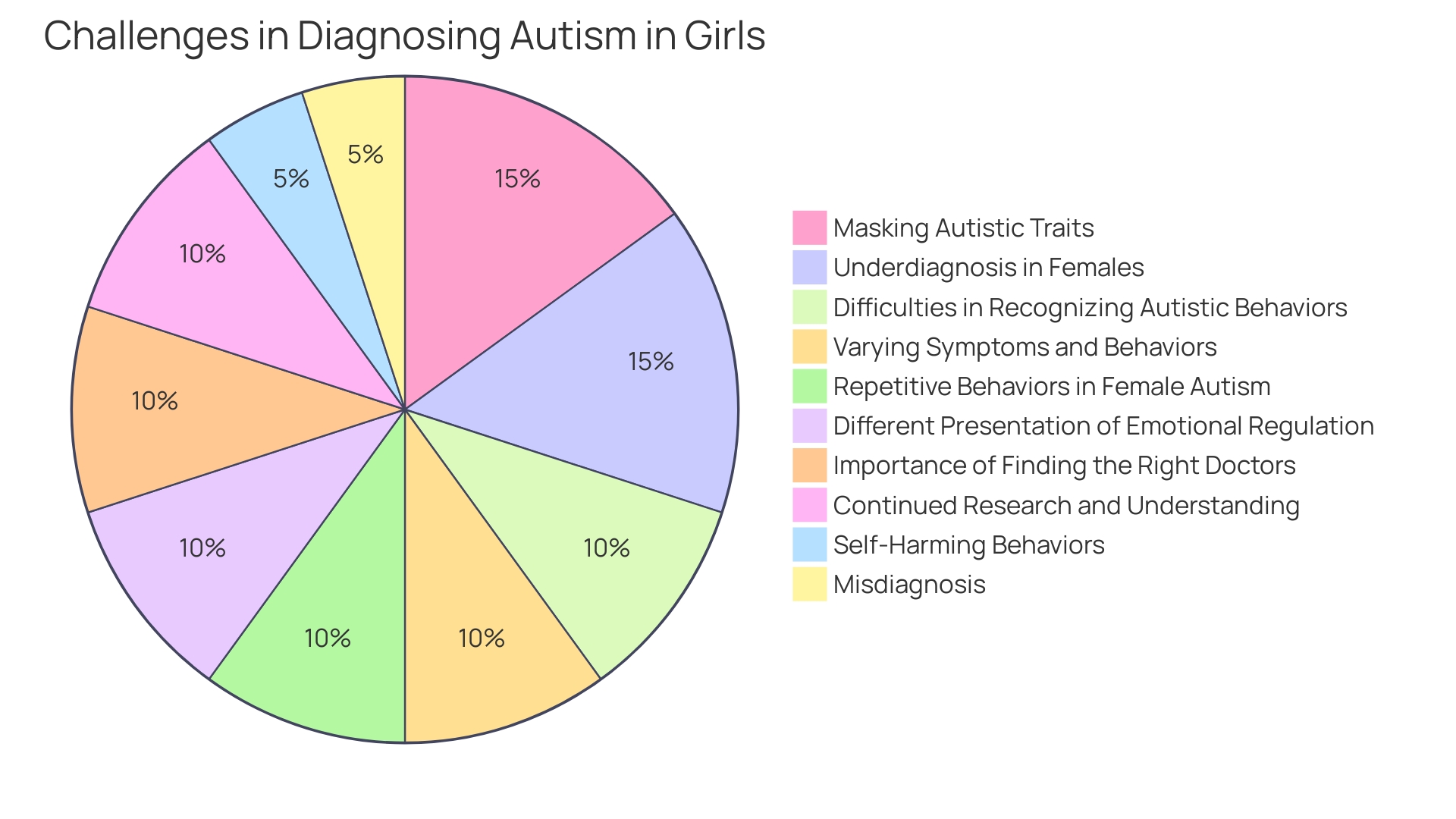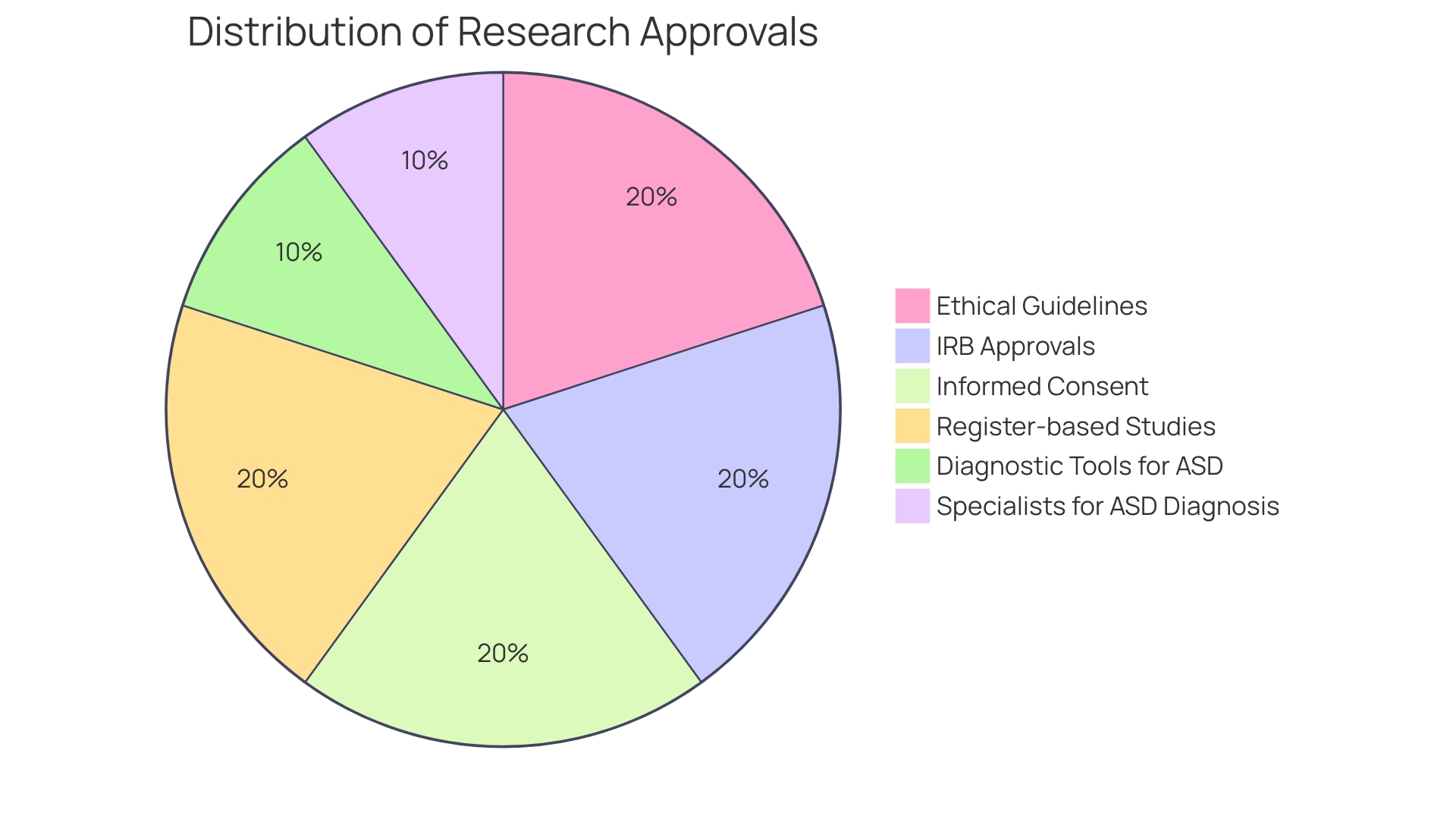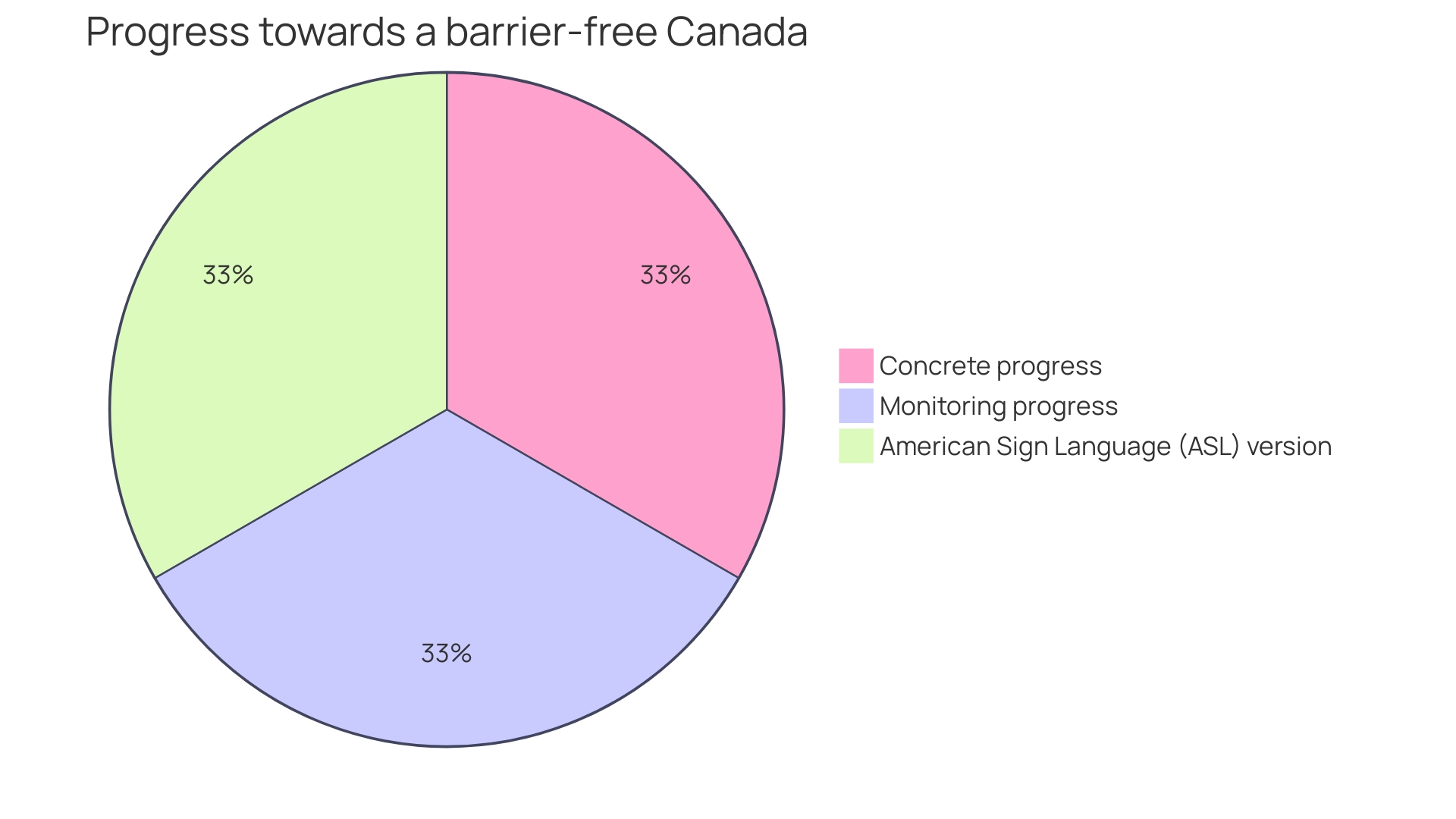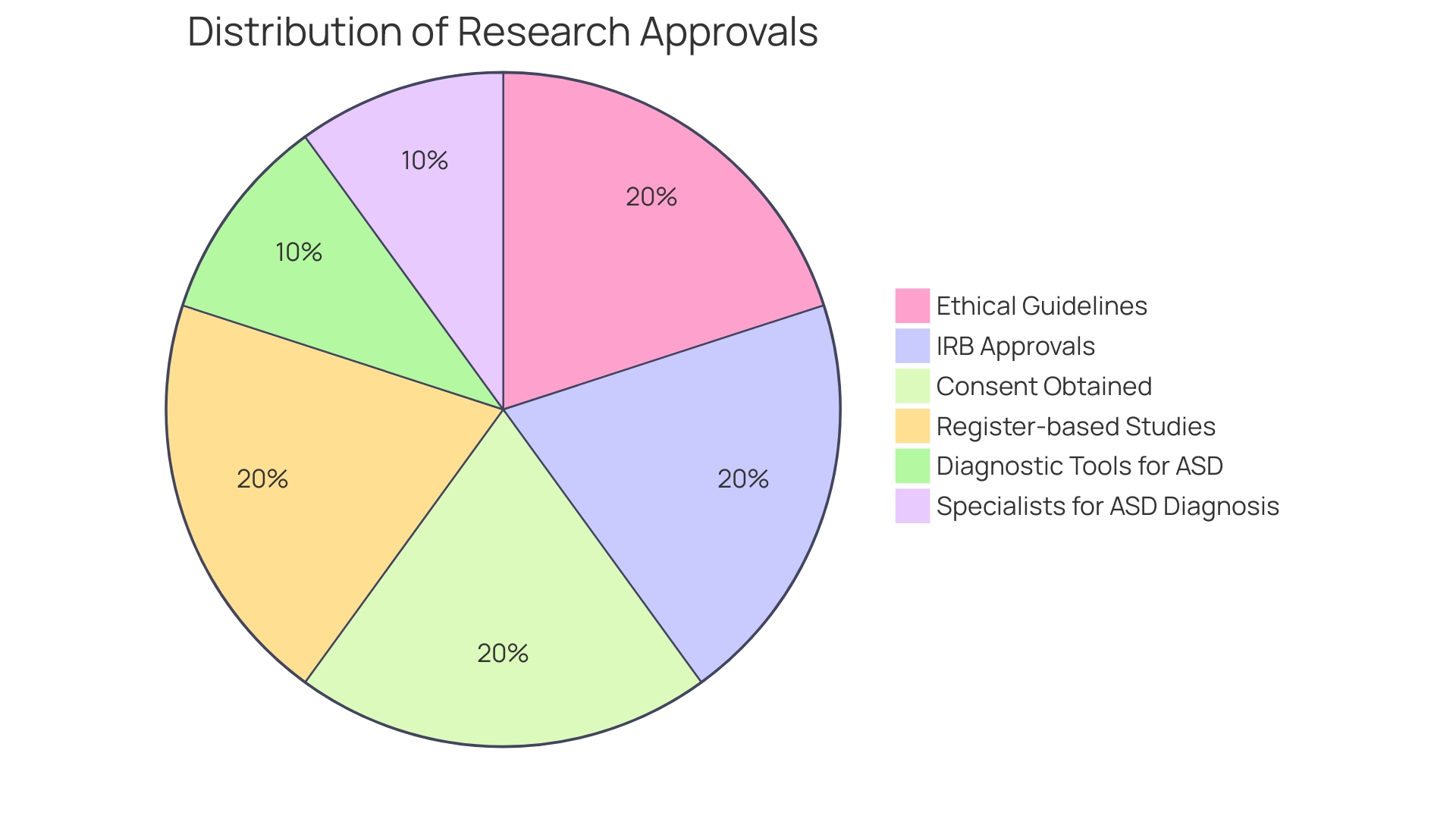Introduction
Autism Spectrum Disorder (ASD) is a complex neurodevelopmental condition that affects individuals in various ways. With challenges in social communication and repetitive patterns of behavior, individuals with ASD navigate a spectrum of symptoms and skill levels unique to them. The diversity within the spectrum is akin to the broad range of conditions in mental health, showcasing the richness and unique experiences that individuals with ASD bring to society.
Recent advancements, including the use of AI in early diagnosis, offer promising support for understanding and addressing the needs of individuals with ASD. It is crucial to broaden our collective understanding of ASD, as this will pave the way for a more inclusive and supportive environment for individuals with autism. Through stories of thriving neurodivergent individuals, we can appreciate the vast potential that lies within the spectrum.
By acknowledging and embracing this diversity, we can ensure the well-being and success of children with ASD and empower them to reach their full potential.
Definition and Characteristics of Autism Spectrum Disorder
Autism Spectrum Disorder (ASD) encompasses a complex array of neurodevelopmental states that impact individuals differently. Individuals with ASD commonly face continual challenges in social communication and exhibit restricted, repetitive patterns of behavior. As a spectrum, ASD hosts a diversity of symptoms and skill levels, which can manifest uniquely across different individuals.
The intensity and combination of these symptoms can vary widely, making each person's experience with ASD distinct. This variation is akin to the broad range of conditions affecting mental health, which do not necessarily confine a person's capabilities but are part of their unique life experience, acknowledged by the wider community for the diversity they bring to society. Recent advancements, such as the deployment of AI in early diagnosis, offer promising support in understanding and addressing the needs of individuals with ASD.
Acknowledging the spectrum's breadth, it's vital to recognize that while some may have a profound understanding of how ASD affects behavior and communication, this awareness is not universal. The call to broaden our collective understanding of ASD is echoed in stories shared by neurodivergent individuals thriving in various fields, illustrating the spectrum's vast potential.
Diagnosis of Autism Spectrum Disorder
The process of diagnosing Autism Spectrum Disorder (ASD) is a thorough and multi-faceted journey that involves a collaborative team of professionals, such as psychologists, speech-language pathologists, and occupational therapists. They conduct a detailed evaluation of an individual’s behavior, communication abilities, and social interaction patterns. Part of this assessment may include discussions with parents or caregivers to understand the individual's developmental milestones and history.
The Diagnostic and Statistical Manual of Mental Disorders, Fifth Edition (DSM-5) serves as the cornerstone for identifying the diagnostic criteria for ASD, providing specific guidelines for clinicians to ascertain if an individual's symptoms align with an ASD diagnosis.
Notably, while professional diagnosis is instrumental for many, it's important to recognize that the autistic and neurodivergent community welcomes self-identification. Given that some adults may receive inconclusive results from medical assessments, an official diagnosis is not always necessary for personal validation or to obtain the needed support. Furthermore, it's estimated that ASD occurs in up to 1 in 36 individuals, according to the CDC.
This illuminates the spectrum’s broad prevalence and underscores the importance of early diagnosis to facilitate access to supportive resources.
In tandem with conventional diagnostic methods, innovative approaches are emerging. The Autism Community in Action (TACA) and companies like NeuroQure are revolutionizing early detection by developing diagnostic tools aimed at identifying ASD shortly after birth. With promising technologies like AutMedAI, which boasts an 80% accuracy rate for children under two, the path to diagnosis and subsequent intervention may become more efficient and less arduous.
The significance of an early and accurate diagnosis cannot be overstated. It is the gateway to early intervention programs that can profoundly impact areas such as language development, social skills, and behavior management. Such programs are often supported by the National Disability Insurance Scheme (NDIS) in Australia, which focuses on providing customized support plans for children with autism.
As research continues to investigate the brain structure and genetic factors involved in autism, it's also crucial to dispel myths, such as the false notion that vaccines cause autism.
Understanding ASD is a continuous learning process for everyone involved, including parents, educators, and healthcare providers. It's about recognizing the diverse manifestations of ASD and advocating for the rights and inclusion of individuals with autism in all facets of society, from education to employment.
Signs and Symptoms of Autism Spectrum Disorder
Autism Spectrum Disorder (ASD) is a neurological and developmental condition that emerges in early childhood and continues throughout a person's life, influencing behavior, social skills, and communication. The signs of ASD may vary widely, but often include challenges with social interactions such as difficulty making eye contact or engaging in back-and-forth conversation. Repetitive behaviors are another hallmark of the condition, with individuals sometimes showing repetitive hand movements or intense fixations on specific objects.
Sensory sensitivities are also prevalent, where a person may experience over- or under-reaction to sensory inputs like sounds, lights, or textures.
In addition to these core characteristics, individuals with ASD might struggle with nonverbal communication cues and face challenges adjusting to changes in routines or environments. Recognizing these symptoms is critical for early diagnosis, which can lead to early intervention and support, enhancing the individual's ability to navigate their environment and live a fulfilling life. It's estimated that as many as 1 in 36 individuals are affected by autism, highlighting the importance of awareness and understanding of this spectrum condition.
Contrary to outdated misconceptions, autism is not linked to parenting styles, vaccines, or nutrition. Instead, differences in brain structure or function, heredity, and genetics are areas being explored by researchers to understand the causes of ASD. With advancements in technology, such as the use of artificial intelligence for early diagnosis, there is hope for breakthroughs in understanding and supporting those on the autism spectrum.
Meanwhile, communities continue to develop resources and interventions tailored to the needs of those with autism and their families, ensuring inclusive support systems that acknowledge the unique experiences of each individual with ASD.
Prevalence and Demographics of Autism Spectrum Disorder
Autism Spectrum Disorder (ASD) is a prevalent neurodevelopmental disorder that presents in early childhood. Current estimates suggest that about 1 in 54 children in the United States are affected by ASD. This condition knows no social, racial, or economic boundaries and is seen across all demographics.
However, it is identified more frequently in boys than girls. Early signs are typically noticed by the age of 3, making early childhood a critical period for diagnosis and intervention.
In the context of Australia, ASD diagnosis does not have an age limit, reflecting the importance of recognizing autism at any stage in life. The diagnosis process is thorough, involving specialists such as pediatricians, psychologists, speech therapists, and occupational therapists. These professionals work collaboratively to collect detailed information from various sources, including observations of the child and insights from parents, caregivers, and educators.
Recognizing the significance of timely intervention, Australia's National Disability Insurance Scheme (NDIS) plays a crucial role in supporting children with autism. The NDIS provides tailored funding for services that assist in early intervention, aiming to address communication, social skills, behavior, sensory processing, and adaptive skills. This approach is bolstered by services from non-governmental organizations and community groups offering therapy, parent training, and support groups.
Recent advancements in research have led to the development of machine learning models such as AutMedAI, which shows promise in identifying ASD with approximately 80% accuracy in children under two years old. This innovative tool relies on analyzing 28 parameters that can be collected without extensive assessments, potentially revolutionizing early diagnosis and paving the way for more effective early intervention strategies.

Risk Factors and Causes of Autism Spectrum Disorder
Autism Spectrum Disorder (ASD) is a complex condition with no single known cause. Research highlights that both genetics and environment may influence the development of ASD. It's characterized by persistent challenges in social interaction, speech and nonverbal communication, and the presence of restricted and repetitive behaviors.
These features are often recognized within the first two years of life and affect individuals differently, hence the term 'spectrum.' According to the CDC, as many as 1 in 36 individuals may be affected by autism.
Brain scans of individuals with autism show distinct differences in shape and structure compared to those without, suggesting that these neurological variations are a factor. While certain genetic mutations and chromosomal abnormalities have been identified as increasing the risk for ASD, many cases arise without a clear genetic link. Prenatal risks, such as exposure to specific medications or maternal infections during pregnancy, have also been investigated for their potential role in the development of autism.
Importantly, misconceptions about the causes of autism, such as vaccinations or parenting practices, have been debunked by scientific research. In some families, patterns of autism or related disabilities may suggest a genetic component, yet the search for exact causes continues.
This information, grounded in scientific research, is crucial for understanding autism. It underscores the importance of early diagnosis and intervention, which can greatly benefit individuals with ASD, providing them with the necessary resources and support to thrive.

Impact on Daily Life and Development
Autism Spectrum Disorder (ASD) presents a unique set of challenges that affect individuals throughout their lives. The way autism manifests can significantly influence a person’s social capabilities, communication skills, and general adaptability. For instance, transitioning to new life stages or environments can be particularly daunting due to unfamiliar routines and expectations.
This was evident in the case of Lil, a 17-year-old transitioning from a special school to a new educational setting, underscoring the importance of personalized support during such changes.
Embracing the diverse experiences of autistic individuals is crucial. The 'I am' Digital Story initiative exemplifies an approach that empowers autistic youth, acknowledging their insights and fostering self-awareness. It is essential to recognize that autistic individuals are not a homogeneous group; their voices and experiences are as varied as those of any other community.
Recent studies have revealed an alarming gap in our understanding of autism in adulthood. While significant strides have been made in early diagnosis and intervention, which is now estimated to affect 1 in 36 children, there remains a lack of knowledge about the experiences of autistic adults, particularly as they age. This underscores the need for continued research and resources to support autistic individuals throughout their lifespan.
In addition, the latest findings from the Canadian Survey on Disability indicate a rise in reported disabilities, including those related to mental health among youth and working-age adults. The data, reflecting 27% of Canadians over 15 years of age living with disabilities, highlights the growing need for accessible services and inclusive policies.
Autism is not just a diagnosis; it is an integral part of the lives of many. Its influence can inspire personal growth and community involvement, as shared by individuals who have found autism to be a catalyst for positive change in their lives. Their stories remind us that with understanding, support, and hope, people with ASD can lead fulfilling lives and make meaningful contributions to society.

Types of Behaviors and Cognitive Abilities in Autism Spectrum Disorder
The spectrum of Autism Spectrum Disorder (ASD) showcases a diverse range of abilities and challenges unique to each individual. While some may excel in certain domains, such as the arts or analytical thinking, others might face difficulties in intellectual functioning. Recognizing these differences is crucial for nurturing the development and well-being of those with ASD.
Stories like that of Zhu Jingxiu, a 12-year-old boy from China who thrives in painting and music despite his autism diagnosis, highlight the remarkable potential within this community. Zhu, affectionately known as 'Xiaoxiu,' uses his artistic gifts to communicate his inner experiences, showcasing how individuals with autism can express themselves in extraordinary ways.
Autism affects over 10 million people in China alone and presents challenges in social interaction and communication. However, embracing the strengths of individuals with ASD can lead to a deeper understanding of the condition and more effective support. Research indicates that those on the autism spectrum may possess heightened attention to detail and excel in STEM fields, suggesting that when provided with the right environment and encouragement, their unique skills can flourish.
In the workplace, the neurodiversity movement is gaining traction, acknowledging the valuable contributions of individuals with ASD to various sectors.
Understanding the full scope of autism requires a holistic approach that considers both the genetic and environmental factors at play. Scientific studies continue to explore the neural circuits and sensory hypersensitivities common in ASD, aiming to improve the quality of life for those affected. Early intervention and personalized support, such as those provided by the National Disability Insurance Scheme (NDIS) in Australia, are pivotal in enhancing communication, social skills, and overall functioning.
Education and inclusion remain essential rights, and with an estimated 1 in 70 Australians on the autism spectrum, it is imperative to foster an environment that nurtures the potential of every child with ASD. As societal acceptance grows, so too does the understanding that autism is not a burden but a different kind of human operating system, capable of making significant contributions to society.

Early Signs and Screening Tools
Spotting early signs of autism spectrum disorder (ASD) is vital for early intervention, which can significantly influence a child's development. Early signs can vary but often include an absence of social smiling, delayed speech or babbling, limited or no eye contact, and a lack of interest in social games or pretend play. To aid in early detection, healthcare providers utilize various screening tools such as the Modified Checklist for Autism in Toddlers-Revised with Follow-Up (M-CHAT-R/F) during routine well-child visits around 18–24 months.
While the M-CHAT-R/F is notably accurate in research environments, its effectiveness can be less in real-world settings, with a study revealing its sensitivity to be only 39.0% in primary care. This underscores the necessity for more reliable, objective, and scalable screening methods to minimize disparities in early diagnosis and access to interventions.
Innovative technology, like eye-tracking, is advancing the early identification of ASD by providing objective insights into a child's developmental progress. Eye-tracking, in particular, has shown promise in discerning visual attention differences that are characteristic of autism, thus aiding in earlier and more accurate diagnoses. The ongoing integration of eye-tracking and other technological tools in both research and clinical practice is part of a broader initiative to refine the diagnostic process.
As a part of a comprehensive assessment by professionals, including pediatricians and therapists, technology serves as an additional resource that, along with clinical judgment, can help streamline the identification of autism during the crucial early years of a child's development.
Importance of Early Intervention and Treatment
The significance of early intervention for children with Autism Spectrum Disorder (ASD) cannot be overstated. Research consistently underscores the profound impact that timely and intensive behavioral interventions can have on the developmental trajectory of young individuals with ASD. These interventions, which may encompass applied behavior analysis (ABA), speech, and occupational therapies, are designed to enhance communication, bolster social skills, and foster adaptive behaviors.
Tailored to address the unique needs of each child, these evidence-based practices lay the groundwork for more equitable opportunities in education, social engagement, and overall mental well-being.
According to experts, early diagnosis and intervention can be life-changing, setting the stage for better outcomes. In fact, machine learning technologies are emerging as valuable tools for early detection of ASD, providing the potential for earlier support. With advancements in research methodologies, including randomized-controlled trials, the effectiveness of interventions can be more accurately assessed, informing clinical decisions and refining treatment approaches.
Despite a variety of opinions in the field regarding the intensity and type of intervention, the ultimate goal remains the same: to equip children with ASD and their families with the necessary resources to thrive.
Dr. David (Dan) R. Offord, a prominent child psychiatrist, emphasized the importance of a fair and supportive environment for all children, particularly those with disabilities such as ASD. This vision aligns with ensuring children with ASD receive the resources required to participate meaningfully in school, home, and leisure activities. Early intervention serves as a critical element in this vision, as it helps reduce the risks of exclusion and promotes a more inclusive society where every child has the chance to succeed.
Common Challenges and Support Needs
Autism Spectrum Disorder (ASD) presents a range of challenges that can persist through life, including during pivotal transitions such as moving from adolescence to adulthood. For instance, individuals like Lil, facing the leap from special education to community involvement, may encounter heightened anxiety and uncertainty. This is a critical period that demands tailored support to navigate new environments and routines, as highlighted in the story of Friends of St James Park in Southampton, UK, which offers autistic individuals a blend of community engagement and skill-building opportunities.
The need for specialized support extends beyond adolescence. Research, including insights from Gregory Wallace, PhD, highlights a knowledge gap concerning autistic adults, particularly in middle and older age. Despite an increase in autism diagnoses, with the CDC reporting a prevalence of 1 in 36 children, our understanding of autism in adulthood remains limited.
Educational methods such as the TEACCH approach recognize that individuals with autism benefit from consistency and visual learning. By structuring classrooms to align with these needs—through visual schedules and clear boundaries—educators can significantly improve academic and social outcomes.
However, challenges persist outside the classroom, particularly regarding societal acceptance and access to services. Reports of autistic adults being turned away by healthcare providers underscore the importance of training professionals to meet their unique needs. Programs like the Kevin and Avonte Program, which received $10.3 million in grants since its inception, demonstrate the positive impact of targeted initiatives.
These programs address critical issues such as wandering, a behavior with potentially life-threatening consequences.
Moreover, state Medicaid plans are instrumental in providing care for the autism community, with nearly one-fifth of the U.S. population insured by Medicaid. As we advocate for the reauthorization of the Autism CARES Act, it's vital to ensure continued and expanded support for those with autism, emphasizing the importance of understanding and addressing the complex challenges they face throughout their lives.
Resources and Advocacy for Families
Navigating the journey of Autism Spectrum Disorder (ASD) as a family involves more than just understanding the condition; it requires accessing a wealth of resources and support that evolve with ongoing research and insights. Engaging with organizations and support groups provides a lifeline for families, connecting them with the latest treatments, educational strategies, and community programs. For instance, educational treatments like the Treatment and Education of Autistic and Related Communication-Handicapped Children (TEACCH) are designed to leverage the strengths of individuals with autism, emphasizing consistency and visual learning, thus improving academic outcomes and daily life skills.
The dynamic nature of ASD means that new findings emerge regularly. Caregivers play a pivotal role in staying informed about the latest developments, including scrutinizing the benefits and risks associated with new medications and therapies. It's crucial for families to engage with credible sources and experts to discern valuable information from misleading narratives that populate the internet.
As underscored by Dr. David (Dan) R. Offord, equitable support for children with disabilities is vital for their mental health and the well-being of society. This includes not only identifying their needs but also the unique contributions they can make to their communities.
Statistical data and research, such as those approved by the Danish Data Protection Agency and funded by the National Institutes of Health, provide a backbone of evidence that supports the interventions and strategies employed by caregivers and professionals. In regions like Australia, comprehensive assessments by multidisciplinary teams form the basis of diagnosing ASD, with initiatives like the National Disability Insurance Scheme (NDIS) offering tailor-made support plans. These plans often include essential early intervention programs focusing on communication, social skills, and behavior management to enhance children's development.
The commitment to 'getting it right for every child,' as stated by the Scottish Government, reflects the global dedication to ensuring that every child and young person with ASD can achieve their full potential. Education authorities and advocacy groups are tasked with making efficient provisions for the additional support required, which is a cornerstone of creating inclusive educational environments and fostering the holistic growth of individuals with ASD.
Conclusion
In conclusion, Autism Spectrum Disorder (ASD) is a complex condition that affects individuals uniquely. Recent advancements, like AI in early diagnosis, offer promising support for understanding and addressing the needs of individuals with ASD. It's crucial to broaden our understanding of ASD and embrace the diversity within the spectrum.
Early diagnosis is important for accessing resources and interventions. Recognizing the signs of ASD, such as challenges in social interactions and repetitive behaviors, is essential. Dispelling myths about the causes of autism is crucial for promoting understanding.
ASD presents unique challenges throughout life. Embracing the diverse experiences and strengths of individuals with ASD is crucial. Early intervention and personalized support enhance communication, social skills, and overall functioning.
Families navigating ASD require specialized support and access to resources. Staying informed about the latest research and engaging with credible sources is vital. Caregivers play a vital role in advocating and accessing necessary resources.
By understanding ASD, embracing diversity, and accessing support, we can ensure the well-being and success of individuals with autism. Together, we can create an inclusive and supportive environment that nurtures the potential of every child with ASD.
Stay informed and engage with credible sources to support individuals with autism.




